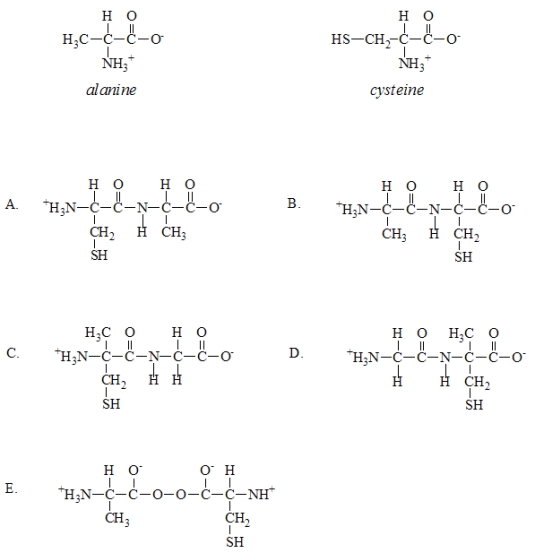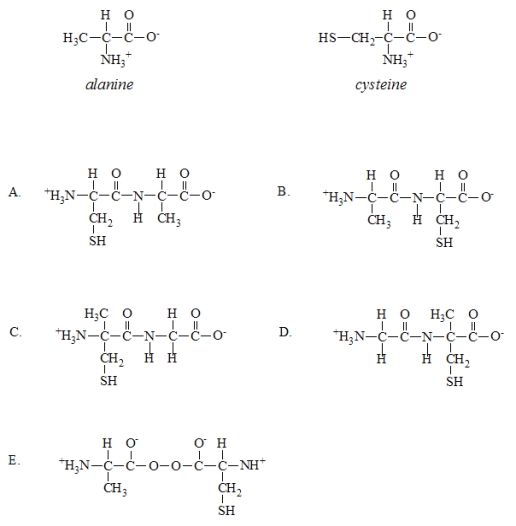A) are relatively inelastic.
B) never occur in nature.
C) produce structurally weak materials.
D) contain no peptide bonds.
E) are not involved in hydrogen bonds.
G) None of the above
Correct Answer

verified
A
Correct Answer
verified
Multiple Choice
Cysteine and methionine are unique among the twenty essential amino acids in that they
A) are chiral.
B) contain an aromatic ring.
C) do not form dipolar ions.
D) contain sulfur.
E) cannot join with other amino acids to form peptides.
G) C) and D)
Correct Answer

verified
Correct Answer
verified
Multiple Choice
Which one of these molecules could not serve as a monomer for an addition polymer?
A) ClCH=CH2
B) H2C=CH-CN
C) H2C=CH-C6H5
D) ![]()
E) ![]()
G) C) and E)
Correct Answer

verified
Correct Answer
verified
Multiple Choice
A peptide bond (also called an amide bond) joins two amino acids together.What atoms are linked by this bond?
A) C - O
B) C - H
C) C - N
D) N - S
E) S - C
G) A) and E)
Correct Answer

verified
Correct Answer
verified
Multiple Choice
Which of the structures below corresponds to the dipeptide cysteylananine? The parent amino acids are shown below. 
A) A
B) B
C) C
D) D
E) E
G) B) and D)
Correct Answer

verified
Correct Answer
verified
Multiple Choice
The functional group  found in proteins is called a (an)
found in proteins is called a (an)
A) amide.
B) carboxylic acid.
C) amine.
D) amino acid.
E) dipeptide.
G) D) and E)
Correct Answer

verified
Correct Answer
verified
True/False
Hydrogen bonding, dispersion forces, ionic forces, and dipole-dipole forces all affect the structure of a protein?
B) False
Correct Answer

verified
Correct Answer
verified
True/False
The primary structure of a protein refers to the unique amino acid sequence of the polypeptide chain.
B) False
Correct Answer

verified
Correct Answer
verified
Multiple Choice
Acrylonitrile results from the polymerization of 
A) A
B) B
C) C
D) D
E) E
G) D) and E)
Correct Answer

verified
Correct Answer
verified
True/False
Both DNA and RNA have double-helical structures.
B) False
Correct Answer

verified
Correct Answer
verified
Multiple Choice
A protein that has been reversibly denatured has
A) temporarily lost part or all of its secondary or tertiary structure.
B) temporarily lost part or all of its primary structure.
C) been genetically modified due to errors in the nucleotides in the parent DNA.
D) temporarily lost its amino acid residues.
E) temporarily lost the hydrogen bonding between nitrogenous bases.
G) D) and E)
Correct Answer

verified
A
Correct Answer
verified
Multiple Choice
The secondary structure of a protein is the
A) configuration of those parts of the chain stabilized by a regular pattern of covalent bonds between C and O groups of the backbone of the chain.
B) configuration of those parts of the chain stabilized by a regular pattern of hydrogen bonds between CO and NH groups of the backbone of the chain.
C) specific order of amino acids in the chain.
D) overall three-dimensional structure of the molecule.
E) overall arrangement of several polypeptide chains into one functional unit.
G) D) and E)
Correct Answer

verified
Correct Answer
verified
Multiple Choice
The only true hydrocarbon polymer found in nature is
A) rubber
B) nylon
C) Tyvek
D) polystyrene
E) neoprene
G) B) and D)
Correct Answer

verified
Correct Answer
verified
Multiple Choice
The backbone of a strand of nucleic acid consists of
A) phosphate units only.
B) phosphate and sugar units.
C) polyester.
D) phosphate, sugar, and nitrogen base units.
E) sugar units only.
G) B) and C)
Correct Answer

verified
Correct Answer
verified
Multiple Choice
Poly(vinyl chloride) results from the polymerization of 
A) A
B) B
C) C
D) D
E) E
G) A) and B)
Correct Answer

verified
Correct Answer
verified
Multiple Choice
The intermolecular force between bases on the opposite strands of DNA responsible for its double-helical structure is
A) hydrogen bonding.
B) dispersion force.
C) covalent bonding.
D) ionic force.
E) dipole-dipole force.
G) B) and C)
Correct Answer

verified
Correct Answer
verified
Multiple Choice
Which of the structures below corresponds to the dipeptide alanylcysteine? The parent amino acids are shown below. 
A) A
B) B
C) C
D) D
E) E
G) A) and C)
Correct Answer

verified
B
Correct Answer
verified
Multiple Choice
Phosphorus is an essential mineral element.It is an important atom in which one of the following?
A) amino acids
B) proteins
C) polyethylene
D) nylon
E) DNA
G) B) and C)
Correct Answer

verified
Correct Answer
verified
True/False
The monomer used to prepare polyvinyl chloride (PVC)is CHCl=CHCl.
B) False
Correct Answer

verified
Correct Answer
verified
Multiple Choice
Which one of these materials is a copolymer?
A) Styrene-butadiene
B) polyvinyl chloride
C) polypropylene
D) poly-cis-isoprene
E) polyethylene
G) None of the above
Correct Answer

verified
Correct Answer
verified
Showing 1 - 20 of 50
Related Exams